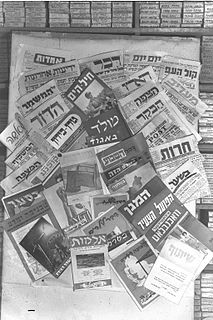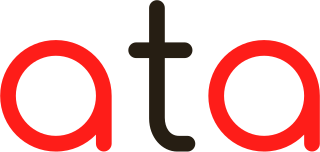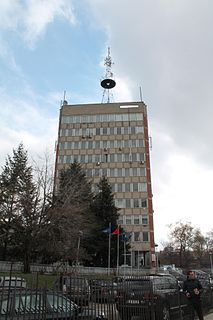The mass media in Poland consist of several different types of communications media including television, radio, cinema, newspapers, magazines, and Internet. During the communist regime in Poland the Stalinist press doctrine dominated and controlled Polish media. The country instituted freedom of press since the fall of communism. The Polish media system's main features are the product of the country's socio-political and economic post-communist transition. These features include: the privatisation of the press sector; the transformation of the state radio and television into public broadcasting services; influx of foreign capital into the media market and European integration of audiovisual media policies. Today the media landscape is very plural but highly polarized along political and ideological divides.
Public broadcasting involves radio, television and other electronic media outlets whose primary mission is public service. Public broadcasters receive funding from diverse sources including license fees, individual contributions, public financing and commercial financing.

The media of Canada is diverse and highly regionalized. News media, both print and digital and in both official languages, is largely dominated by a handful of major media corporations. The largest of these corporations is the country’s national public broadcaster, CBC/Radio-Canada, who also plays a significant role in producing domestic cultural content, operating radio and TV networks in both English and French.
Television in Albania was first introduced in 1960. RTSH dominated the Albanian broadcasting field up to the mid-1990s, a period when privately owned radio and TV stations started to occupy the vast empty Albanian frequencies.
There are several different types of mass media in the United Kingdom: television, radio, newspapers, magazines and websites. The United Kingdom is known for its large music industry, along with its new and upcoming artists. The country also has a large broadcasting and film industry.
Mass media in Nepal include radios, televisions, newspapers and the online services.

Top Channel is a national commercial television network based in Tirana, Albania, founded by Dritan Hoxha in 2001.

Radio Televizioni Shqiptar is an Albanian public broadcasting radio and television company. Founded in 1938, it operates several radio and television channels, over a domestic transmitter network as well as satellite. The international television service via satellite RTSH Sat was launched in 1993 and is aimed at Albanian-speaking communities in Kosovo, Serbia, North Macedonia, Montenegro, and northern Greece, plus the Albanian diaspora in the rest of Europe. RTSH is funded by a combination of commercial advertising, an annual licence fee of US$10.00 and grant-in-aid from the Albanian government.

Media in Cambodia is vibrant and largely unregulated. This situation has led to the establishment of numerous radio, television and print media outlets. Many private sector companies have moved into the media sector, which represents a significant change from many years of state-run broadcasting and publishing.
The South Korean mass media consist of several different types of public communication of news: television, radio, cinema, newspapers, magazines, and Internet-based websites.
The mass media of Transnistria, the breakaway territory within the borders of Moldova, features both state-owned or supported outlets and opposition media. Publications are in Russian, with a single newspaper in each of the other two official languages, Moldovan (Romanian), and Ukrainian.

The mass media in Israel refers to print, broadcast and online media available in the State of Israel. The country boasts dozens of newspapers, magazines, and radio stations, which play an important role by the press in political, social and cultural life and cater it to a modern, developed and literate society.
Mass media in Albania refers to mass media outlets based in Albania. Television, magazines, and newspapers are all operated by both state-owned and for-profit corporations which depend on advertising, subscription, and other sales-related revenues. The Constitution of Albania guarantees freedom of speech. Albanian media are quite diverse, although politicised, and often influenced by business and political interests.
The mass media in North Macedonia refers to mass media outlets based in North Macedonia. Television, magazines, and newspapers are all operated by both state-owned and for-profit corporations which depend on advertising, subscription, and other sales-related revenues. The Constitution of North Macedonia guarantees freedom of the press and of expression, yet they are not upheld impartially by the authorities. As a country in transition, North Macedonia's media system is under transformation.

Television, magazines, and newspapers have all been operated by both state-owned and for-profit corporations which depend on advertising, subscription, and other sales-related revenues. Even though the Constitution of Russia guarantees freedom of speech the press has been plagued by both government censorship and self-censorship.

Algeria has more than 45 independent Arabic language and French language publications as well as 4 government-owned newspapers, but the government controls most printing presses and advertising. The Algerian newspapers with the largest circulations are Echourouk (1,800,000), Ennahar (1,600,000), El Khabar (1,000,000) and Quotidien d'Oran (700,000); all four are employee-owned. In 2004 and 2005, the government increased the access of Berber language and culture to both print and broadcast media.
The mass media in Syria consists primarily of television, radio, Internet, film and print. The national language of Syria is Arabic but some publications and broadcasts are also available in English and French. While television is the most popular medium in Syria, the Internet has become a widely utilized vehicle to disseminate content. Transcending all available media, the government seeks to control what Syrians see by restricting coverage from outside sources. Publications and broadcasts are monitored by members of the government. Syria is ranked as one of the most dangerous places in the world for journalists. There were 28 journalists killed in combat in 2012.

The Albanian Telegraphic Agency is the official multimedia news agency of the Albanian government. Its content is published in some of the main news agencies around the world of which it has contractual agreements with, such as: AFP, DPA, ANSA, Xinhua, Anadolu, etc. The agency is a member of the European Alliance of News Agencies (EANA), the Alliance of Mediterranean News Agencies (AMAN) and the Association of the Balkan News Agencies (ABNA).
The mass media in Belgium is characterized by its diversity due to the linguistic divide in the country.

The mass media in Kosovo consists of different kinds of communicative media such as radio, television, newspapers, and internet web sites. Most of the media survive from advertising and subscriptions.







